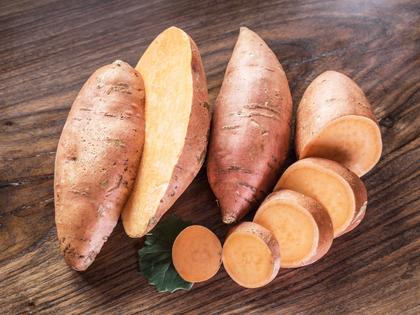Environmental Nutrition: How sweet (potato) it is!
A sweet potato by any other name is still a rich source of antioxidant and anti-inflammatory nutrients, most notably, beta carotene.
The folklore
Sweet potato or yam? Chances are it's a sweet potato. These tubers (Ipomoea batatas) are not related to the yam (Dioscoreae alata), a rough and starchy root vegetable. When the now familiar orange-fleshed sweet potato first arrived in the U.S., people knew only the white fleshed variety, so producers called the newcomer "yams," from the African word for sweet potato "nyami" to distinguish one from the other. This Central and South American sweetie has been traced back 10,000 years in Peruvian caves.
The facts
The sweet potato, a member of the morning glory family of plants, is not related to the potato (Solanum tuberosum), providing its own unique flavor and nutritional punch. Common varieties like Garnet or Japanese Purple have different textures (firm and dry or soft and moist) and degrees of sweetness. One medium sweet potato has 103 calories, yet packs 438% DV (DV=Daily Value, based on 2,000 calories/day) of vision protecting vitamin A, 37% DV of antioxidant vitamin C, and the powerful, health-promoting compounds, beta carotene and anthocyanins, giving yellow/orange and purple potatoes their color.
The findings
The sweet potato ranked number one among all vegetables from a dietary point of view and nutritional perspective, according to a review of studies in different countries (Food Science & Nutrition, 2019), due in part to its significant vitamin A content. Compared with white and yellow fleshed varieties, orange fleshed sweet potatoes are a good source of dietary fiber, important in protecting against diabetes, as well as certain minerals, vitamins, and antioxidants (Global Journal of Science Frontier Research: D Agriculture and Veterinary, 2016). Evidence links sweet potatoes to anticancer activities due to phytochemical content (Journal of Cancer Prevention, 2017).
The finer points
Peak season for sweet potatoes is October through December, but they are available all year. Select small and medium sweet potatoes for a sweeter, moister flesh and those with smooth, firm, and blemish-free skin. The deeper the color of the skin, the richer it likely is in beta-carotene (or anthocyanins for purple varieties). Store in a cool, dark, well ventilated place, but do not refrigerate. Bake them whole and top with healthy yogurt, nuts and a drizzle of maple syrup, mash with regular potatoes for fun flair, cut into fries and roast, or bake cooked flesh into your favorite pancake, muffin and cookie recipes.
(Environmental Nutrition is the award-winning independent newsletter written by nutrition experts dedicated to providing readers up-to-date, accurate information about health and nutrition in clear, concise English. For more information, visit www.environmentalnutrition.com.)











Comments